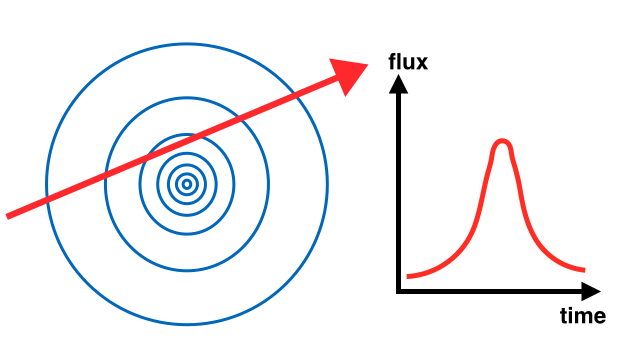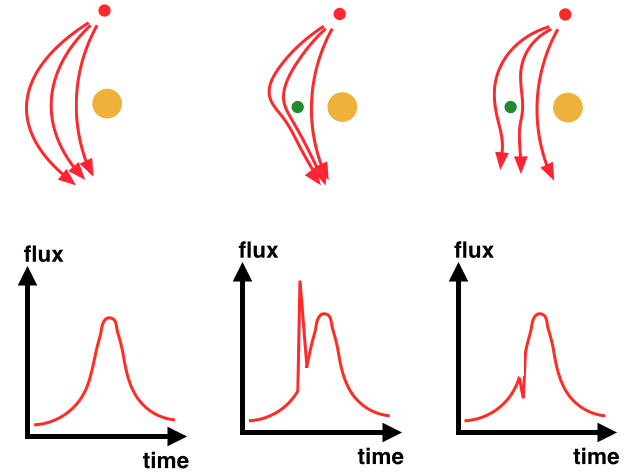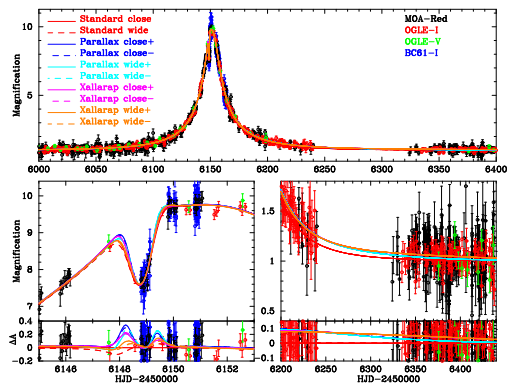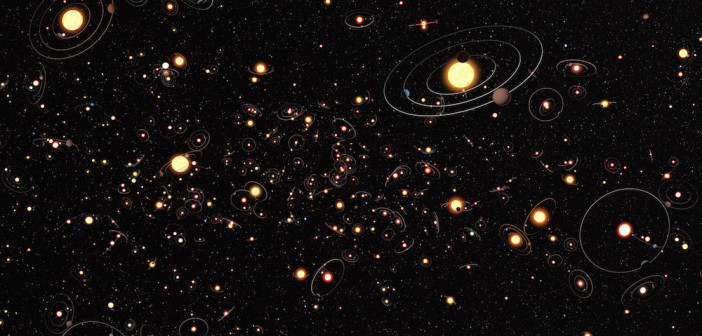Editor’s note: Astrobites is a graduate-student-run organization that digests astrophysical literature for undergraduate students. As part of the new partnership between the AAS and astrobites, we will be reposting astrobites content here at AAS Nova once a week. We hope you enjoy this post from astrobites; the original can be viewed at astrobites.org!
Title: OGLE-2012-BLG-0950Lb: The First Planet Mass Measurement from Only Microlens Parallax and Lens Flux
Authors: N. Koshimoto, A. Udalski, J.P. Beaulieu et al.
First Author’s Institution: Department of Earth and Space Sciences, Osaka University, Japan
Status: Accepted in AJ
In today’s paper, we’re looking at a planet discovery. The planet in question is called OGLE-2012-BLG-0950Lb. That’s a bit of a mouthful, so for the purposes of this article I’m going to nickname it Oggy.
Oggy is an unusual planet. It’s intrinsically fairly normal: a planet roughly the size of Neptune, orbiting an M-dwarf star. But Oggy is 3 kiloparsecs, or 9,800 light years, away, making it one of the most distant planets ever discovered. That’s because it was discovered via the microlensing technique.
A Quick Microlensing Primer:
Microlensing is a bit of a forgotten relative of observational exoplanet science — we hear about transit and radial velocity planets all the time, and direct imaging is intuitively simple and makes pretty pictures, so it gets lots of press time too. The microlensing technique, meanwhile, has been quietly churning out planet detections since 2004. And yet, if you asked your average exoplanet scientist how microlensing works, they’d probably panic and mutter something about general relativity before running away as soon as possible.
Microlensing works like this: your system consists of a lens star, which magnifies light from a source star. The source star is moving relative to the lens, and the closer it gets to the lens, the more the light rays are bent, and the more the lens magnifies the source. One could plot contours of equal magnification — they would be circles, traced around the lens star, as I’ve tried to demonstrate in Figure 1. The closer to the lens, the more a source would be magnified. The background source will move across the diagram following the red arrow, and as the flux increases and then decreases a flux peak is observed.

Figure 1: On the left, the blue contours show regions of equal magnification — increasing towards the centre where the star is positioned. On the right is the sort of flux curve you’d observe as the source passes behind the lens, following the red arrow. [Astrobites]

Figure 2: Three lens diagrams for the three possible scenarios. Left: a source is magnified by a lens star. Centre and right: the lens star now hosts a planet, which also warps the light: either enhancing or reducing the lens effect for a short period of time, and creating an additional bump or dip on top of the lensing curve. [Astrobites]
Applying this to Oggy:
During the summer of 2012, two different microlensing surveys — one called OGLE and one called MOA — both independently identified a flux ramp-up around the same star. A source was just beginning its journey behind a lens. They monitored the event, and I’ve shown their data in Figure 3. This matches the situation in Figure 2: there’s a wide peak as the source passes behind the star, and a teensy dip at day 6149, where the planet briefly dims the source — a zoom-in of this dip is shown in the bottom panel.

Figure 3: The microlensing event where planet Oggy was identified. Top: the whole event as the source star passes behind the lens. Bottom left: a close up of the effect of the planet on the observed flux. Bottom right: a close up of the final dimming of the event as the source passes out from behind the star. [Koshimoto et al. 2016]
However, the total passage of the star is a fairly long event, with the star being magnified for a total of ~120 days. This means that the orbital motion of the Earth during the microlensing event is actually detectable! The models that include the so-called ‘microlens parallax’ are shown in Figure 3, and they fit better than those that ignore the Earth’s motion. For completeness, the authors also use a third model, one they call the xallarap model, where the orbital motion of the lens is considered (kind of like a backwards parallax). However, this is found to be a less good fit than the parallax model.
By determining the microlens parallax, and with some additional Keck telescope observations that confirm the flux of the lens star, the authors calculate a mass for the planet and for the star. It’s 35 times the mass of the Earth, orbiting an M-dwarf host star, with a projected distance of three times the Earth–Sun distance. Oggy is the first planet for which a mass has been determined with just the parallax and the lens flux.
So, why should you care?
Microlensing is exciting as it’s the only method that can find these extremely far away planets. This allows us to figure out whether our part of the galaxy is representative: does the galactic bulge have as many planets as we do out here in a spiral arm? Are the planets in the galactic bulge generally bigger or smaller than ours? For now, microlensing is the only technique that can answer this question.
Since several microlensing surveys are now being carried out with simultaneous ground and space observations (using the Spitzer and Kepler telescopes), there will be more and more planets identified where the microlens parallax can be very precisely determined — so the method used here will be valuable in calculating masses for these future discoveries. Oggy is a great benchmark, proving that these missions will give valuable scientific output.
About the author, Elisabeth Matthews:
I’m currently a second year PhD student at the University of Exeter, in the south of England, where I’m aiming to detect and characterise extra-solar planets and debris disks via direct imaging. So far this has meant lots of detecting background stars that happen to be near bright, nearby stars and no detecting of actual planets — but hopefully my luck will change soon!


1 Comment
Pingback: the microlensing planet "Oggy"